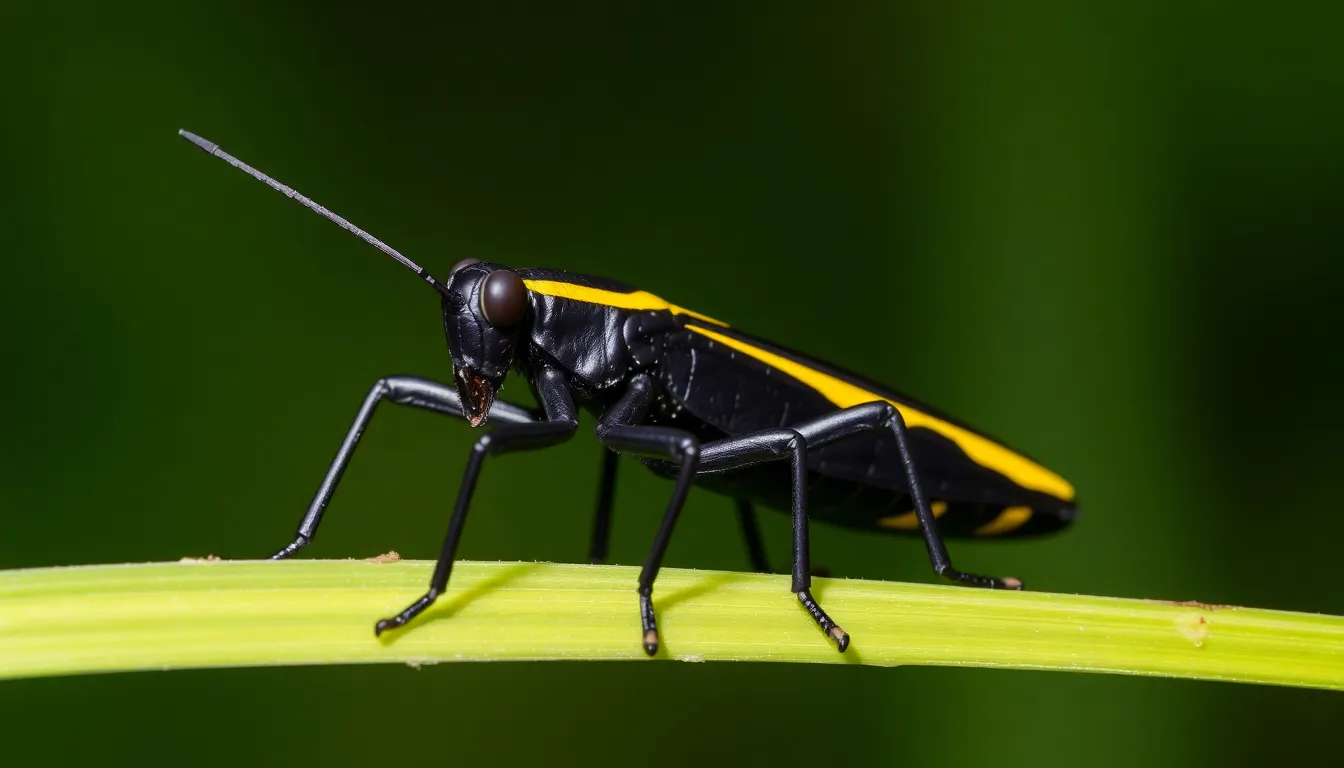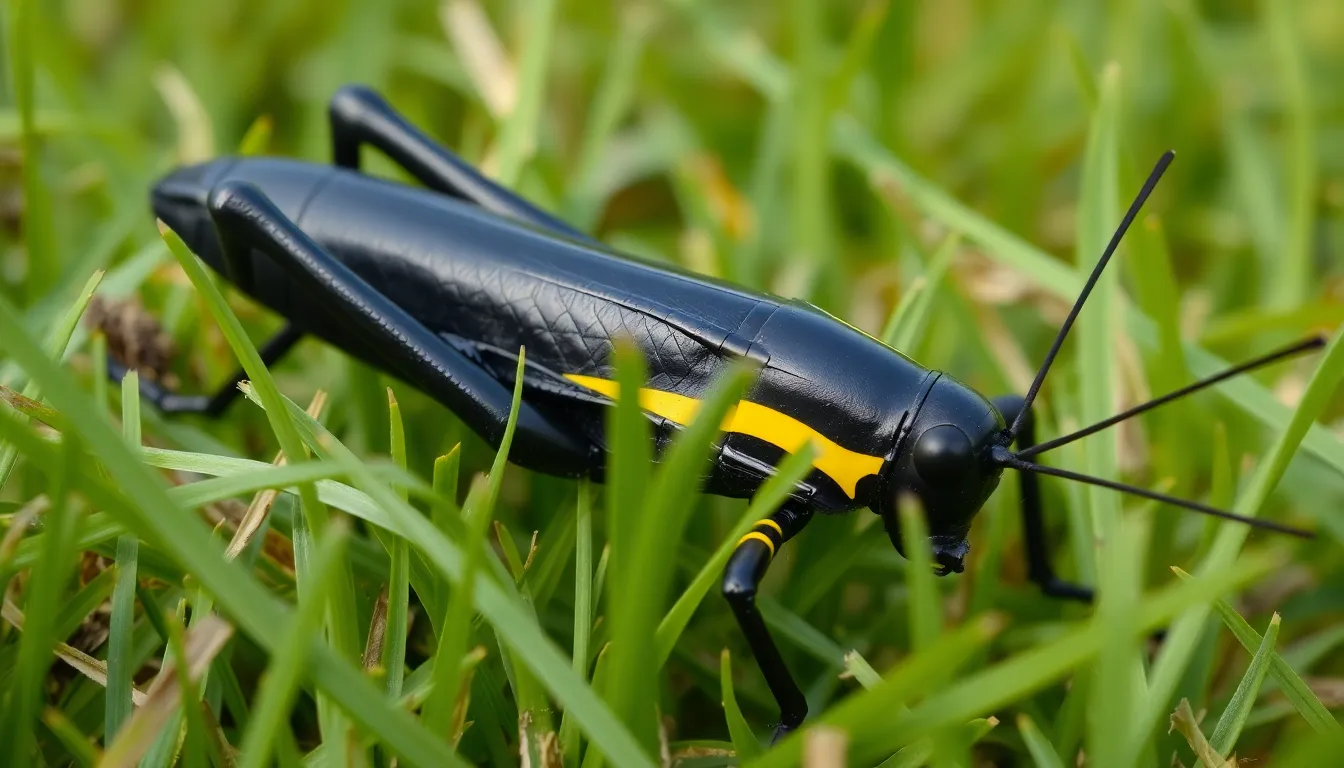Have you ever spotted a black grasshopper with a striking yellow stripe and thought, “Is that a fashion statement or just nature showing off?” This little critter isn’t just a sight for sore eyes; it’s a testament to the wonders of evolution and adaptation. With its bold colors and agile movements, this grasshopper captures attention and sparks curiosity.
Overview of Black Grasshopper With Yellow Stripe
Black grasshoppers with a yellow stripe exhibit striking physical characteristics that allow for easy identification. These insects display a glossy black body complemented by a vivid yellow stripe running along their sides. This coloration serves not only for aesthetic appeal but also as a form of camouflage against predators found in their natural habitat.
Inhabiting grassy fields and open areas, these grasshoppers thrive in warm climates. Adaptations to their environment enhance their agility, allowing them to evade threats. Adult black grasshoppers with yellow stripes can measure up to 2 to 3 inches in length, providing a substantial presence among smaller insect species.
Diet consists mainly of grass, leaves, and other plant materials, making them herbivorous. This diet supports both growth and reproduction, contributing to their population in various ecosystems. Furthermore, high reproductive rates lead to increased numbers during peak seasons, influencing local food chains.
Behaviorally, these grasshoppers are known for their impressive jumping abilities. Jumping can reach distances several times their body length, aiding in escape from potential threats. Communication among individuals involves auditory signals, which consist of stridulation, a sound produced by rubbing their wings together.
Research highlights their role as indicators of environmental health. Observing black grasshoppers with yellow stripes can provide insight into the overall conditions of grassland ecosystems. Naturalists and entomologists alike recognize these insects as fascinating subjects for study, showcasing evolution and adaptation in action.
Physical Characteristics

These grasshoppers exhibit distinctive features that contribute to their appeal and adaptability. Their physical traits include notable size and color patterns.
Size and Shape
Adult black grasshoppers with yellow stripes average 2 to 3 inches in length. Their bodies are elongated, featuring a robust shape that allows for efficient movement. Wings typically span 2 inches, enabling impressive leaps and flight. The legs are muscular, facilitating powerful jumps to escape predators. Antennae extend beyond their bodies, enhancing sensory perception. Together, these physical aspects empower the grasshopper’s agile lifestyle.
Color Patterns
The primary coloration showcases a glossy black body contrasting against a striking yellow stripe. This bold yellow line runs along the sides, creating a vibrant visual effect. The black coloring provides effective camouflage among grass and dark soil. Additionally, variations may occur in specific populations, leading to subtle differences in hues or patterns. Overall, these color patterns serve dual purposes of attracting mates and deterring potential threats.
Habitat and Distribution
This black grasshopper with a yellow stripe thrives in specific environments conducive to its lifestyle.
Preferred Environments
Grassy fields and warm climates serve as ideal habitats for this species. They prefer areas with abundant vegetation, providing ample food sources such as grass and leaves. High grass and low shrubs protect them from predators while offering suitable locations for laying eggs. Moisture-rich environments support their developmental stages, making wetlands and meadows attractive to them. Such spaces encourage healthy populations, contributing to their role in local ecosystems.
Geographic Range
This grasshopper can be found across various regions, primarily in North America. Populations inhabit the southeastern and central United States, extending to parts of Mexico. Each region presents conditions that support their growth and reproduction. Elevation influences their distribution, with these grasshoppers often found at lower altitudes where warmth allows year-round activity. Seasonal migrations may occur in search of food and suitable climates, expanding their range during warmer months.
Behavior and Diet
Black grasshoppers with yellow stripes exhibit fascinating behaviors related to their feeding and reproduction. Understanding these aspects provides insight into their ecological role.
Feeding Habits
These grasshoppers primarily consume grasses, leaves, and various plant materials. In grassy fields and meadows, they find abundant vegetation to support their herbivorous diet. Soft plant tissue serves as a main food source, ensuring optimal growth and energy. These insects also possess strong mandibles that allow for efficient cutting and chewing. Relatively high moisture levels in their habitat enhance food quality and availability. Foraging mainly occurs during daylight, increasing their chances of finding nutritious plants.
Mating and Reproduction
During the mating season, male black grasshoppers attract females using stridulation, a process involving the rubbing of their wings. Females typically select mates based on song quality and physical attributes, contributing to genetic diversity. After mating, females lay clusters of eggs in soil or leaf litter, ensuring protection. These eggs later hatch into nymphs, resembling miniature adults. Development progresses through several molts, with optimal growth occurring in warm, moist conditions. Seasonal variations influence reproduction timing, with a peak in spring and summer. This cycle supports healthy population dynamics in their native ecosystems.
Importance in Ecosystem
Black grasshoppers with yellow stripes play a crucial role in their ecosystems. These insects serve as herbivores, consuming large amounts of grass and leaves, which aids in plant growth and biodiversity. By feeding on vegetation, they help maintain balance within their habitats, preventing overgrowth and promoting healthy ecosystems.
Predators benefit from the presence of these grasshoppers as well. Birds, small mammals, and reptiles often rely on them as a food source, contributing to the food web’s stability. Maintaining the populations of these grasshoppers ensures a steady supply of prey for various predators.
Moreover, the grasshoppers act as indicators of environmental health. Their populations respond quickly to changes in habitat quality, making them valuable subjects for ecological research. Tracking these insects provides insights into habitat conditions, allowing scientists to assess the impacts of environmental changes or climate fluctuations.
Pollination is another essential aspect of their ecosystem contribution. While primarily herbivorous, black grasshoppers can inadvertently assist in the pollination process. Their movement through plants disrupts flowers, aiding in the transfer of pollen among various plant species.
Providing habitat for other organisms, these grasshoppers contribute to a complex web of interactions. As they lay eggs in soil or leaf litter, their reproductive cycle supports healthy population dynamics. This process also offers shelter for other small insects, enhancing local biodiversity.
By understanding the importance of black grasshoppers with yellow stripes, individuals gain a deeper appreciation for their role within the broader ecosystem. Such knowledge encourages conservation efforts, emphasizing the need to protect these fascinating insects and their habitats.
The black grasshopper with a yellow stripe stands as a remarkable example of nature’s creativity and adaptability. Its striking appearance not only captivates but also serves vital ecological functions. By understanding its role in the ecosystem and the importance of preserving its habitat, individuals can foster a deeper appreciation for these unique insects. Observing them in their natural environment offers insights into the intricate balance of life within grassland ecosystems. Protecting these fascinating creatures ensures the health of their habitats and the overall biodiversity of the regions they inhabit.













